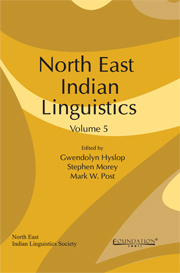Book contents
- Frontmatter
- Contents
- About the Contributors
- Foreword
- A Note from the Editors
- Contact and genetic linguistics
- Historical-comparative Tibeto-Burman grammar
- The North East Indian noun phrase
- Assamese grammar
- Advances in Boro-Garo phonology
- 11 Tiwa tones in monosyllables
- 12 The ‘sixth’ vowel in the Boro-Garo languages
- Poetics and text
11 - Tiwa tones in monosyllables
from Advances in Boro-Garo phonology
Published online by Cambridge University Press: 05 September 2013
- Frontmatter
- Contents
- About the Contributors
- Foreword
- A Note from the Editors
- Contact and genetic linguistics
- Historical-comparative Tibeto-Burman grammar
- The North East Indian noun phrase
- Assamese grammar
- Advances in Boro-Garo phonology
- 11 Tiwa tones in monosyllables
- 12 The ‘sixth’ vowel in the Boro-Garo languages
- Poetics and text
Summary
Introduction
Tiwa, also known as Lalung, is a Tibeto-Burman language of the Bodo-Garo subfamily, and has 27,072 speakers in the Indian state of Assam. Not much is known about the linguistic features of the Tiwa language, and still less is known of its phonology. In this work, we investigate the tones of the Tiwa language with the help of instrumental acoustic measures supported by statistical tests in order to determine the types of tones that exist in the language. We also examine the acoustic characteristics that may help native speakers to distinguish the tones in Tiwa. Furthermore, we investigate how tones operate in non-derived monosyllabic words in the language.
By means of acoustic measures of speech samples collected from nine speakers, plus interviews with native speakers of the language, we come to the conclusion that Tiwa has two lexical tones: a falling tone and a rising tone, and that fundamental frequency (F0) or pitch serves as the major cue in distinguishing among the tones. We also demonstrate that Tiwa is a word-tone language system in which only one tone is assigned to each lexical word of the language, regardless of its syllable quantity.
As with most of the Bodo-Garo languages, not much has been written about Tiwa language. However, the tone systems of the subfamily have received considerable interest; for example, by Baro (1991), Basumatary (2005), Bhattacharya (1977), Burling (1959), Halvorsrud (1959), Joseph and Burling (2001, 2007), Sarmah and Wiltshire (2010a), and Weidert (1987).
- Type
- Chapter
- Information
- North East Indian Linguistics , pp. 249 - 270Publisher: Foundation BooksPrint publication year: 2013



